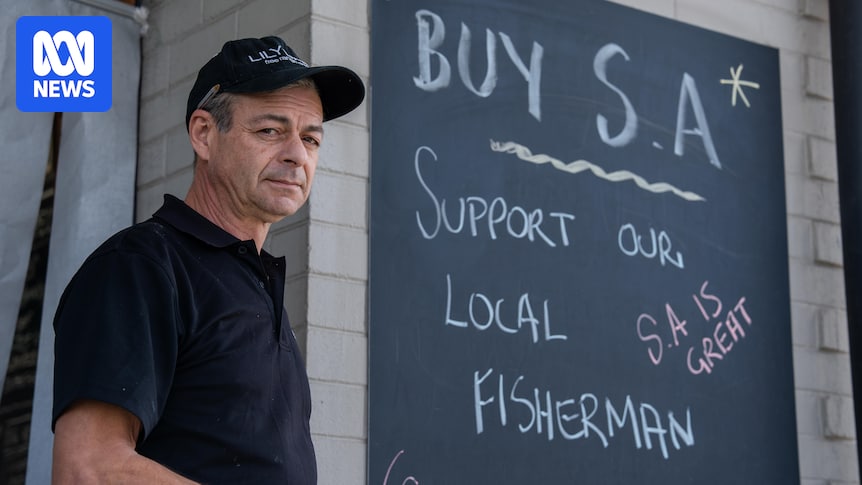Local seafood is a point of pride for takeaway shop owner and former fisherman Anthony Salkicevic.
But recently, some customers have been getting nervous about his fish.
“The beach is only two minutes away, you go for a walk down there, they do come across the dead product and they’re very concerned,” he said.
“They still will purchase it, but it has dropped 10 to 15 per cent.”
Many South Australians have still been keen to back local fish shops since the harmful algal bloom started hitting parts of the coast.
What is happening with SA’s algal bloom?
Among them is Harry Kaplatzis, who, along with his wife, was recently tucking into fish and chips on a park bench on the main street of Semaphore.
“We’re not only supporting them, but we’re giving other consumers confidence that it is safe to eat,” he said.
“We don’t have any problems eating the fish … I’m still alive!” said Peter Schultz, who was walking on a jetty where dead fish could be seen below.
Other locals have not kept the same appetite.
“We certainly haven’t been eating any or buying any local seafood since the algal bloom,” Kerryn Suthern said.
Fish and chips remain on the menu for some consumers, but not others. (ABC News: Ashlin Blieschke)
The bloom has killed thousands of sea creatures and destroyed local marine habitats since it was first reported on the state’s Fleurieu Peninsula in March.
It has spread along the Coorong North Lagoon, Yorke Peninsula and Kangaroo Island, and into Spencer Gulf and Gulf St Vincent.
Fishing businesses and scientists have told the ABC that catches went down 50 per cent in some parts of South Australia.
But much of the state’s waters have been spared so far.
“We are still sitting at around 73 per cent of the state’s coastline unaffected by the algal bloom,” Premier Peter Malinauskas on Thursday said.
Fishers said many people had the wrong idea about commercial seafood and assumed it was caught in the affected waters.
Signs have been put up in some shops to let consumers know it’s safe for them to eat local fish that has not been impacted by the algal bloom. (ABC News: Ashlin Blieschke)
Craig McCathie, who runs a fresh seafood shop in Port Lincoln at the southern end of Eyre Peninsula, believes media coverage of the algal bloom hasn’t helped the industry.
“There wasn’t the positive side of the messaging to say that seafood was safe to eat all that time,” he said.
‘Good that they do ask the questions’
Government health authorities have insisted commercial seafood is safe to eat, but public concern left many shops eager to provide reassurance.
A sign at Somerton advising beachgoers amid SA’s algal bloom, including of fishing. (ABC News: Isabel Dayman)
Mr Salkicevic has kept a long hand-written note at the counter detailing each catch.
Others have made their own signage.
A US study published in 2023 found long-term messaging about the safety of eating seafood during a harmful algal bloom did more to put people at ease than last-minute comfort at the register.
The study, published in the journal Harmful Algae, examined the impacts of algal blooms on the consumption of red grouper — a fish commonly caught in the South Atlantic.
Anthony Salkicevic says some of his customers have been nervous about eating local seafood amid the toxic algal bloom affecting SA’s beaches. (ABC News: Ashlin Blieschke)
It found that consumers who were given health and safety information were “more likely to say that they would be willing to consume red grouper during a bloom, relative to consumers who were not provided this added information”.
The SA Health website provides advice on what is and what is not safe to eat.
On July 25, updated advice said while some seafood, such as bivalve molluscs and abalone that “you catch and collect yourself” should not be eaten, “all commercially available seafood (purchased in a shop or restaurant) from South Australian waters is safe to eat“.
Last week the SA government said $750,000 from the existing $28 million algal bloom support package would go into statewide public information campaigns.
SA fishers urge people to keep buying seafood amid algal bloom
“For the entirety of our coastline, seafood that comes out of it is perfectly safe to eat,” Mr Malinauskas said.
At the announcement event, he ate local prawns in front of the cameras, alongside chief public health officer Nicola Spurrier, and continued to spruik his taste for local seafood in home cooking videos posted to social media.
But Mr Salkicevic said safety messaging had not completely cut through.
“I don’t think they’re advertising it properly,” he said.
That sentiment was echoed at Grange — a coastal suburb of Adelaide that is brimming with fish and chip cafes and restaurants.
“I haven’t heard that message,” said walker Hayley Andreazza.
“I’d still be cautious.”
Craig McKay said he’s grateful for more community awareness so people can support local seafood. (ABC News: Ashlin Blieschke)
Fish and chip shop owner Craig McKay said he welcomed more community awareness.
“The public need to continue to support their local fishmongers, their local fish and chip shops, and understand that everything’s 100 per cent safe,” he said.
Mr McKay said he empathised with anyone who was worried, given what people could see on the beach.
“That’s why it’s good that they do ask the questions and understand that businesses aren’t going to put people’s heath at risk,” he said.

